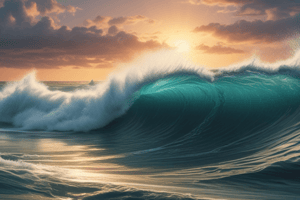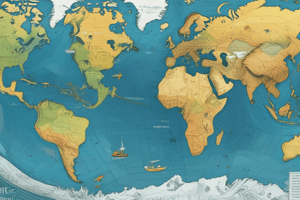Podcast
Questions and Answers
What is the primary force responsible for the changing levels of the oceans?
What is the primary force responsible for the changing levels of the oceans?
- Buoyancy
- Gravity of the sun
- Human power
- Tidal force (correct)
According to the passage, what can tidal forces cause besides changes in ocean levels?
According to the passage, what can tidal forces cause besides changes in ocean levels?
- Lifting buckets of water
- Watering the garden
- Tripping and falling down
- Mountains to rise and fall, distortion of galaxies, and pulling a person apart as they fall into a black hole (correct)
Why don't you 'fall' down towards the moon when you trip, even though the moon attracts your body?
Why don't you 'fall' down towards the moon when you trip, even though the moon attracts your body?
- The moon's gravity only affects the oceans, not people
- The moon's gravity is not strong enough to overcome Earth's gravity (correct)
- You are not close enough to the moon for it to have a significant gravitational effect
- The passage does not explain why you don't fall towards the moon
What is the mutual force between the Earth and the moon described in the passage?
What is the mutual force between the Earth and the moon described in the passage?
What is the purpose of the analogy of a child helping to water the garden by lifting a bucket of water?
What is the purpose of the analogy of a child helping to water the garden by lifting a bucket of water?
What is the main purpose of the passage?
What is the main purpose of the passage?
What is the key difference between the gravitational pull of the Earth and the gravitational pull of the moon on a person?
What is the key difference between the gravitational pull of the Earth and the gravitational pull of the moon on a person?
What is the primary cause of tides on Earth?
What is the primary cause of tides on Earth?
What is the reason for the occurrence of two tidal bulges on opposite sides of the Earth?
What is the reason for the occurrence of two tidal bulges on opposite sides of the Earth?
Why are the tides caused by the Sun generally smaller than those caused by the Moon?
Why are the tides caused by the Sun generally smaller than those caused by the Moon?
What are 'spring tides', and when do they occur?
What are 'spring tides', and when do they occur?
How do 'neap tides' differ from 'spring tides'?
How do 'neap tides' differ from 'spring tides'?
Why do tides typically rise and fall twice in 24 hours?
Why do tides typically rise and fall twice in 24 hours?
What causes the tidal distortion of the solid parts of the Earth to be much smaller than the tidal bulges in the oceans?
What causes the tidal distortion of the solid parts of the Earth to be much smaller than the tidal bulges in the oceans?
Which of the following factors can alter the typical pattern of tides rising and falling twice in 24 hours?
Which of the following factors can alter the typical pattern of tides rising and falling twice in 24 hours?
Flashcards are hidden until you start studying
Study Notes
Tidal Forces and Tides
- Tidal forces are the differences in the strength of gravity between two points on a body, which can cause deformations of a body, known as tides.
- Tidal forces can lift an entire ocean, cause mountains to rise and fall, distort galaxies, and even pull a person apart as they fall into a black hole.
The Moon's Effects on Tides
- Gravity is a mutual force, and the moon attracts the Earth, just as the Earth attracts the moon.
- The moon's gravity attracts the oceans, causing them to bulge out on the near side of the Earth.
- The moon's gravity also pulls the oceans away from the far side of the Earth, creating another bulge.
- These bulges are known as tidal bulges, and they cause the tides to rise and fall twice in 24 hours.
The Sun's Effects on Tides
- The sun also causes tides, although its effect is less than half that of the moon's due to its greater distance from the Earth.
- When the moon, sun, and Earth align at full moon and new moon, the tidal bulges produced by the sun and moon have an additive effect, causing spring tides.
- When the sun and moon pull at right angles to each other, their tides partially cancel one another out, resulting in neap tides.
Tidal Bulges and Amplitude
- Tidal bulges can be about 3 feet in height in deeper parts of the ocean, and over 40 feet in areas like the Bay of Fundy.
- The maximum tidal distortion of the solid parts of the Earth is only about 20 cm.
- Factors such as latitude, winds, and the shape of the shore can alter the tidal patterns.
Studying That Suits You
Use AI to generate personalized quizzes and flashcards to suit your learning preferences.




